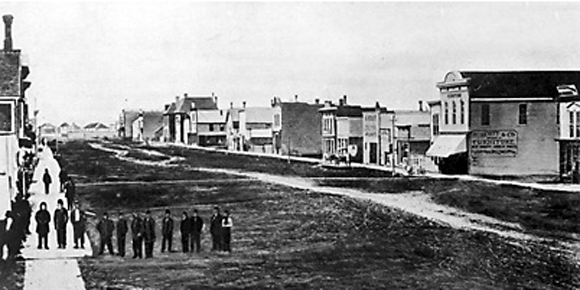by Bruce Cherney (part 3)
In 1872, Alexander McMicken established a private bank in Winnipeg, which George Babington Elliott, a transplanted journalist from Eastern Canada, said was “a two-storey wooden building” on Fort Street. Until the arrival of charter banks, private banks (as well as private individuals with money to loan) played a stop-gap role, and were only limited in their ability to provide loans by the amount of capital entrusted to them by depositors. Since a private bank didn’t operate under a charter, its owner could pick and choose whatever security he thought was required for a loan.
In a May 13, 1894, presentation to the Manitoba Historical Society, George Bryce, a local historian and founding member of the society, said the McMicken Bank provided a valuable service: “But the business of the country needed greater facilities, and on Dec. 14, 1872, the Merchants Bank of Canada was in a building on the west side of Main Street, near the corner of Bannatyne Avenue.” In 1875, the bank founded in Halifax, Nova Scotia, which later merged with the Royal Bank, moved into new $15,000 premises at Main Street and Post Office (now Lombard) Avenue.
In 1878, Thomas Dowse, a “travel writer for hire” from St. Paul, Minnesota, wrote in his pamphlet, Manitoba and the Northwest Territories: The Real Northwest: “Perhaps the greatest necessity for successful business enterprise, mercantile particularly, is proper banking facilities. For so young a city, Winnipeg is remarkably fortunate in this respect, having three solid and substantial (charter) banks.” The Bank of Montréal and the Ontario Bank had joined the Merchants Bank in Winnipeg by 1877.
“Real estate, although appearing high to the resident of an eastern city, is still very low when the prospects of the city are taken into consideration ...,” Elliott commented in his pamphlet, Winnipeg as It is in 1874: And as It was in 1860. “Speculation may be said not (to) have been inaugurated yet, though one operator, Mr. Burrows, has sold over 400 city lots during the past year.”
Alfred W. Burrows resigned as the chief clerk of the Dominion Lands Office in Winnipeg in August 1874 in order to concentrate on his private business as a land agent. The Manitoba Free Press reported on December 22, 1874, that he sold 250 Winnipeg lots while in Montréal.
Within Elliott’s pamphlet, Burrows advertised 1,600 city lots for sale in “the subdivisions of the tracts known as the Mulligan, Land, Ness, Tristan, Sargent, and Magnus Brown properties” in the western and northern portions of Winnipeg.
“Several thousand dollars have already been expended by the proprietor upon these properties, in Sidewalks, Tree Planting, Free Lots for building and residence, and Parks (of which there are two,” according to the advertisement.
Elliott said Burrows “has done very much towards making the city known by his extensive advertising; and he has displayed unusual enterprise in attracting investment.”
According to Elliott, Burrows was in the process of developing the Magnus Brown property, a large tract of about 200 acres. The land development included a park in its centre and a two-mile long drain and a mile-long sidewalk. Burrows gave away about 50 lots “to attract residents, which wise and liberal course has repaid him a hundredfold, and a number of residences now dot the prairie, where a year ago, the long grass waved; and the growth of the city is now permanently fixed in that direction (north along Burrows Avenue).”
Elliott’s pamphlet contained an entry from the September 2 Free Press that mentioned an auction sale of the Magnus Brown homestead — “the Burrows property” at Davis House (hotel), which resulted in 75 lots being sold at an average of $95 each.
Although speculation has not entered the marketplace, Elliott recorded that HBC land along Main Street has doubled in value from $1,000 a lot in 1871 to $2,000 per lot in 1874. He recorded individual sales of HBC reserve lots along streets west of Main auctioned off by Lyster Hayward on October 16, 1874, that netted the Company a total of $25,695. Another sale of 50 lots in 1874 realized in excess of $22,500 for the HBC.
At the time, the HBC owned about 500 acres of land centred around Upper Fort Garry. The HBC possessed the most privately-held property in the city, which was assessed at a value of $273,000.
Single lots in the McDermot estate had increased from $75 to $800 from 1871 to 1874, while each lot in the Schultz estate was selling for $300 in 1874, compared to just $50 in 1871.
John Christian Schultz, who came to Winnipeg from Eastern Canada in 1861, advertised an office on Main Street “next door to (Alexander) McMicken’s Bank. A self-proclaimed doctor — there is no evidence that he actually completed a medical degree — Schultz organized the opposition to Riel. He was briefly imprisoned by Riel, but escaped to Eastern Canada where he drummed up anti-Riel support. In September 1870, he returned to Manitoba and was elected the MP for Lisgar, and eventually was appointed Manitoba’s lieutenant-governor.
In an advertisement in Elliott’s pamphlet, Schultz called himself a “dealer in furs and and real estate,” offering farm and city lots for sale.
In another instance, according to Elliott, an unnamed man arrived in Winnipeg in 1873 with $50 in his pocket, while “today he owns over $800 worth of real estate. Another, a clerk in a store, saved a couple of hundred dollars which he finally decided to invest in a city lot. This sold in a few days at one hundred per cent, advance; then he bought others, and is now the owner of four residences, worth an average $1,000 each, and some other property; and instances are numerous of parties who purchased lots four years ago for $75 now refusing $500 for them.”
Despite Elliott’s denial, it was obvious through his own assertions in his pamphlet that speculation was then a fact of life in Winnipeg.
(Next week: part 4)



